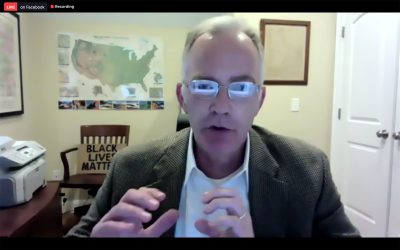With a presidency and 35 Senate seats to decide on in less than a month, candidates are leaving no stone unturned to appeal to their voters. In an age of rapid information dissemination, with multiple ways to reach people, what are the types of advertisements that leave an indelible mark on voters, persuading them to vote for a particular candidate?

Boston University’s College of Communication, as a part of its Virtual Speaker Series, hosted a panel Wednesday entitled, “Political Ads: What Do Candidates Get For $1 Billion?” The event featured COM faculty as well outside strategists from political campaigns.
The webinar began with a discussion of the focus and purpose of advertising. After an introduction to new forms of advertising in the digital sphere, the conversation turned toward the role of television advertising.
Anne Danehy, a senior lecturer in COM and one of Wednesday’s panelists, said in an interview viewers are often not aware of political candidates running for office until they watch their ad on TV.
“Voters spend very little time thinking about politics, and ads oftentimes introduce them to candidates and shape their attitudes and feelings towards the candidate,” Danehy said. “So it’s a very effective way for them to get themselves known to the voters.”
Despite the advent of digital advertising, Danehy said campaigns still spend large amounts of money on television and cable advertising — about two thirds of resources are spent on television advertising, she said.
Tobe Berkovitz, associate professor of advertising in COM, said these sorts of ads are a “broad brush stroke” capable of reaching a larger set of people, including low-interest voters.
“People who are not seeking this information can find them on platforms and in programs that they’re just on for entertainment or for enjoyment or sports,” Berkovitz said in an interview. “And all of a sudden, ads are all over the flat screen, communicating with me.”
The panel discussed five types of political advertisements, talking about what worked and what did not work for each. The panelists agreed the success of political advertisements could not be limited to a one-size-fits-all formula and that a campaign’s strategy determines which ads have a persuasive impact on voters.
The first ad shown was of Sen. Susan Collins, an incumbent Republican from Maine who promoted herself as a bipartisan candidate who got the work done. Danehy called the advertisement Collins’ response to being called “duplicitous.”
Chris Moyer, a Democratic strategist, said in the panel that Collins’ vote for Justice Brett Kavanaugh in 2018 drew criticism, and that using old references such as 9/11 or Hurricane Katrina could be problematic for the ad.
The second advertisement discussed was Alaska’s Independent Senate candidate Al Gross, who called upon people from Alaska with its slogan, “Always Alaska.” The advertisement was shot in the open waters of Alaska and depicted Gross’ strengths as a nonpartisan candidate and a wilderness expert who has “killed a grizzly bear in self defense.”
Matthew Felling, the strategic communications director for Sen. Angus King of Maine, said this quality might not have worked in Gross’ favor in any state other than Alaska.
“Alaska is a very fascinating state and Alaska’s political spectrum is … a burrito, where the spectrum folds over on itself, where the lefties and the righties are both so anti-government that they just start to sound and talk like one another,” Felling said. “I think the bear message communicates very differently to this target demographic than us coastal elites.”
Berkovitz said the advertisement seemed a combination of an action film and a Discovery Channel ad.
“What makes this such a successful ad is it speaks to that Alaskan spirit of independence,” Berkovitz said.
Next was an advertisement from Sen. Ed Markey of Massachusetts that details everything Markey has done — including 500 laws he has helped write. From old footage of Markey’s younger days to Rep. Alexandria Ocasio-Cortez’s support, the advertisement tried to “bridge between two eras,” Felling said.
By making a reference to John F. Kennedy’s famous “ask not” quote — the ad included the line, “It’s time to start asking what your country can do for you” — Markey took a dig at his competitor Joe Kennedy III without mentioning him.
The final advertisement shown during the event was a collaborative effort entitled “Texas Reloaded” by Texas Rep. Dan Crenshaw.
The ad included a team of other representatives and politicians from Texas who promised to strike a chord with the low-interest voters. The superhero feel of the advertisement also contributed to its appeal, Felling said.
“It sort of creates a ‘Godfather’ of young veteran conservative politics in Texas that I find fascinating,” Felling said. “I don’t think it communicated a whole lot about their stances, and I think that that was the point.”
As for what $1 billion would get a candidate, Felling said half of that money must have been spent on Crenshaw’s “movie.”
Over the years, as campaigns both local and national have begun spending exorbitant amounts of money on advertising, doubts about their efficiency have grown.
Danehy said the most efficient ads have three important contributing factors: target audience research, a creative appeal that connects with the voter and a buyer who places ads for viewing.
Even then, every advertisement, whether an attack ad or a soft ad, can be effective — depending on the election, the intensity of the race, the demographics of the voters and a number of other factors, Danehy said.
As a result, it becomes difficult to determine what advertisement would be a complete waste of funds.
In an interview, Berkovitz quoted John Wanamaker, an American merchant and pioneer of advertising: “Half the money I spend on advertising is wasted; the trouble is I don’t know which half.”
But Berkovitz also had a solution to that problem.
“We’ll see who wins,” Berkovitz said, “and then we’ll try to figure out what role advertising plays in that.”















































































































